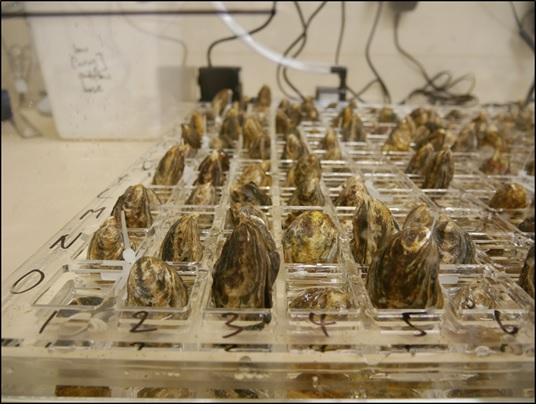Oyster farming to benefit from new genetic screening tool
Oyster farmers are set to benefit from a new genetic tool that will help to prevent disease outbreaks and improve yields.
22 May 2017

The technology will enable hatcheries to rapidly assess the genetic make-up of their oysters, so they can select animals with desirable characteristics from which to breed.
Dr Ross Houston and colleagues at The Roslin Institute have developed a chip loaded with tens of thousands of pieces of DNA – each carrying a specific fragment of the oyster’s genetic code. Using a tiny sample of DNA from each oyster, the chip can measure small genetic variations – known as Single Nucleotide Polymorphisms – that are linked to physical traits.
The tool will initially be used to spot oysters that are resistant to Oyster Herpes Virus, a disease that causes major losses in young stocks. Researchers are also investigating how the chip can be used to identify oysters with other desirable characteristics, such as faster growth rates.
Similar selective breeding techniques are already used to improve the health and productivity of farmed salmon stocks and land-based livestock.
Oysters are one of the most important group of species for global aquaculture with more than 600,000 tonnes produced each year. This chip is an enabling tool for genetics and breeding research in oysters, and we are working with the industry to implement this technology with the goal of improving health and yield of stocks.
This new technology brings the power of selective breeding a step closer for oyster producers in the UK and worldwide
The chip has been developed for two key species – the Pacific oyster, which is the main species of farmed oyster, and the Native European Flat oyster, a locally important breed. Details of the technology are published in the journal G3: Genes, Genomes, Genetics.
The project also involved researchers from the Centre for Environment Fisheries and Aquaculture Science and Edinburgh Genomics. The team is now collaborating with experts from several European countries, Australia, New Zealand and Mexico to apply the technology.
For further information, please contact:
Jen Middleton, Press & PR Office
Tel: 0131 650 6514
Original article: A.P. Gutierrez, F. Turner, K. Gharbi, R. Talbot, N.R. Lowe, C. Peñaloza, M. McCullough, P.A. Prodöhl, T.P. Bean, R.D. Houston (2017) Development of a Medium Density Combined-Species SNP Array for Pacific and European Oysters (Crassostrea gigas and Ostrea edulis) G3: Genes, Genomes, Genetics. DOI: https://doi.org/10.1534/g3.117.041780


